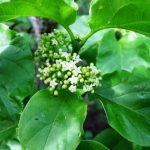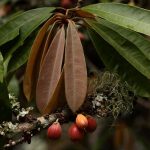TREE LIFE
June 1983
MASHONALAND CALENDAR
Saturday June 4th : Botanic Garden Walk. Meet in the Car Park at 1045 for 1100 hours. Please note later time, as this is more convenient for our host.
Sunday June 19th : Garamwe Farm, Chegutu. This month we join our Chegutu friends again, this time at the home of Olive Reoch. The lower altitude in the area always offers something different for Hararians and the kopjes will undoubtedly prove to be rewarding.
A bus has been arranged which will leave Monomotapa Car Park at 0830 hours. Fare $9.00
BOTANIC GARDEN WALK SATURDAY 7TH MAY 1983.
This walk was the third and last in the series RUBIACEAE ( the Gardenia family). This time we headed for the relatively new Riverine Forest section of the Garden. Here we saw many of the less common species, most painstakingly transplanted or germinated. The stream is now virtually complete and creates a real wet forest atmosphere – despite the drought all the trees are still well watered and lush.
Heinsia crinite, the small false gardenia is a species with a rare ecology. It occurs in places like the Nyoni range, as a riverine fringe species at lower altitudes. In flower it is very showy having white lowers up to 3 cm long. Stipules dry to small spikes before falling off.
Cephalanthus natalensis is a scrambler or gigantic liane of up to 50 m. Of very limited distribution is occurs in montane forest, often on slopes, where it climbs by means of growth of long curved branches. This means of climbing is already apparent in the garden specimen. In the flowering season this species is very showy. Flowers occur in small dense heads which later dry to resemble small strawberries. It is this which gives Cephalanthus its common name of Tree Strawberry.
Canthium is a large and widespread genus, with at least 15 species classified as trees in Zimbabwe. Some are found in low rainfall situations and others in evergreen forest. One of the latter is C. obovatum, although it can occur in scrub and in bush too. It grows to a large size in South Africa, but has been recorded only from two or three places in Zimbabwe, and only one record is of a large tree. The leaves are distinctly obovate, and it has distinctive lateral branching.
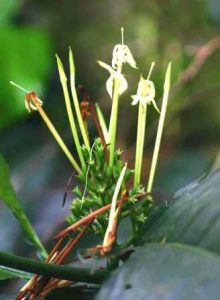
Oxyanthus speciosus flowering. Photo: Bart Wursten. Source: Flora of Zimbabwe
Oxyanthus speciosus, wild loquat or whipstick tree, was mentioned in the last newsletter. However, what we saw last time was certainly not O. speciosus as this weeks specimen was a true tree, whereas the O. oxycarpus we saw last time was part of the understory. O. speciosus occurs at low to medium altitudes in all our low to medium altitude evergreen forests. The leaves are huge (about 30 cm long) as are the stipules which are actually elongated and leaf like in appearance.
In the course of the walk we came across five more canthium species.
Canthium setiflorum, from the Nyoni range, is a shrub, never more than 5 meters. Leaves occur on very shortened side branches, and the yellowish tiny bell like flowers form in axils of leaves.
C. inerme occurs at forest edge and in dry forest. The distinctive feature of this species was that certain side branches had become modified to spines. The bark was whitish and there were numerous side suckers growing upward.
Canthium captum, Chimanimani canthium, is very rare, occurring in high altitude forest edges. Leaves are long with pale midrib and veins.
Canthium bibractiatum has not been recorded until recently from Burma valley. Leaves are very shiny and branches have a horizontal layered appearance.
Canthium pseudoverticillatum is another species of low altitude forest edge, and of very limited distribution.
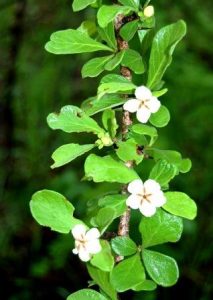
Catunaregam spinosa in flower. Photo: Stefaan Dondeyne. Source: Flora of Zimbabwe
In a particularly overgrown patch are found an enigmatic species, a Xeromphis, but neither is it Catunaregam, as Xeromphis spinosa was changed to. The name still attached to the plant was X. rudis, and nobody could recall the new name. However, a curious looking plant, the leaves were gardenia like in appearance; very shiny, broad and spatulate. There was a great range in leaf size even on any one facile. Unlike its cousin Catunaregam spinosa, this species occurs in high rainfall areas, at the edges of evergreen forest.
Tricalysia congesta is also a shrub of forest edge. Leaves are small, thin and rubbery. Stipules are distinctively square with a spike like tip.
The only Vangueria which Tom aimed to show us was V. apiculata (formerly longicalyx). Despite endless debate and catch phrases like “Vangueria is hairier” we often fail to differentiate V. infausta and Vangueriopsis lanciflora. However Tom avoided the most common Rubiaceae, like V. infausta so we could concentrate on less common species. V. apiculata is rather Vernonia like in appearance of leaves which are furry. Branching is quite distinctive, as new branches come out from leaf bases i.e. development of axial buds. Branches tend to resemble compound leaves as they remain thin and green with the typical Rubiaceae opposite pairs of leaves along them. Stipules are distinctively long, hair like and green.
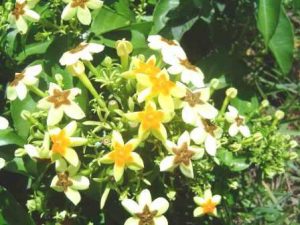
Mussaenda arcuata flowering; Photo: Bart Wursten. Source: Flora of Zimbabwe
Growing near the stream banks was Mussaenda arcuata, in flower. It is a gigantic soft liana, frequently overlooked unless in its star like yellow and brown flowers. It occurs at medium to high altitude. The specimen was in fruit, which closely resemble those of gardenia species. I was interested to read in the Botanical Dictionary that the ‘handkerchief bush’ growing in so many gardens is an Indian species of mussaenda.
Being led an energetic race, we rushed through a variety of, to us, obscure genera.
In the high altitude forest understory, i.e. on Inyangani, one apparently finds three Rubiates, Pauridiantha symplocoides. Tom has battled to grow this species, and it is rare in the wild. In the same habitat Psychotria zombamontana, Psychotria being the other genus with dots in the leaf, and Lasianthus kiliandscharicus also occur.
Another rarity is Tricalysia akokantheroides, which has been recorded only once in Zimbabwe. Here in the gardens it is about to flower.
We glanced briefly at Rytigynia sp. unusual in that it is deciduous although inhabiting rather forested areas, and Cremaspora. How much has sunk in I do not now, but thanks to Tom for the 3-part RUBIACEAE story.
It is worth mentioning the addition to the forest section of all 4 indigenous species of tree fern. The preparation for their arrival, from siting to organizing individual moist sprayers, it quite amazing. Of course they don’t look very beautiful at present, all the green leaves having been cut off to facilitate successful transplanting, but in time they will be a most beautiful asset to the garden.
-C.M.Haxen
BOTANIC GARDEN EXTENSION, CHRISTON BANK 15TH MAY 1983
The flat plateau on which Harare is situated is eroded away towards the north. It was one of these eroded valleys, Christon Bank, that we visited in May. As the bus turned eastwards of the Mazowe road we dropped in altitude and travelled along the length of the valley to the Botanic Gardens Extension where Mr. Bob Drummond was waiting to meet us. Although Christon Bank is only about 24 km from Harare, the vegetation proved to be significantly different for us to find a number of trees to get really excited about.
After hearing a few comments on the history of who donated what to whom, when and why, we set off at a rapid rate along the path descending to the river to appreciate this valuable little gift. It was not long before Bob’s determined effort to get to the river was distracted as little groups of us began our typical Red Riding Hood wander into the woodland, finding yet another tree just a bit further from the path. We all admired the smooth bark of the large mountain acacia Brachystegia glaucescens, with its characteristic craters. On the return from previous trips I seem to have neglected to even notice the main trees in the miombo and so to compensate we took note of them all this time where we were rewarded by finding all three local Brachystegia species. Amongst the rocks we saw the prince of wales feathers, B. boehmii, a similarly magnificent tree but with a rough grey bark. The msasa, Brachystegia spiciformis, was also common on the rocky slopes but is easily identified by its large terminal leaflets.
The sight of soft, slight oval furry leaflets set distinctly sub-opposite to one another in a pinnate arrangement led to the identification of the purple wood . This tree lacks the bunched appearance of the leaves that occurs in the related D. melanoxylon we see so often. Passing the small Euphorbia griseola on the rock face we thought we saw two narrow trunks of Erythrina abyssinica with corky bark, until someone’s keen eye spotted tell tale Cussonia arborea inflorescence protruding from one of the leafless branches – an educational lesson to us all. Leafless trees often result in confusion but we seem to have acquired an eye for the characteristic end twigs of Lannea discolor which was dubbed “dead man’s fingers” on the trip to the Watkins farm last winter, someone thought this should now be updated to “E.T. fingers” which more aptly fits the bill.
Yet another distraction off the path led us to a fine Rhoicissus revoilii in fruit and to collect young buds of the soft green Vernonia colorata which belongs to the COMPOSITAE family, which has now changed name to become the ASTERACEAE. We also found a fruiting Rhus which had very narrow leaves but in an unlikely habitat on the kopje to be R. lancea.
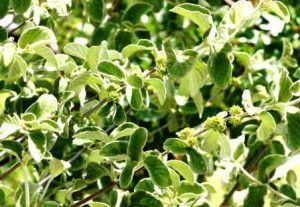
Tapiphyllion velutinum. Photo: Bart Wursten. Source: Flora of Zimbabwe
One of our giraffe like members browsed a short branch for Bob to confirm the identification of R. leptodictya. Back on the path again we passed Tapiphyllion velutinum, one of the RUBIACEAE we have not included in our recent study of this family in the Botanic Garden walks. The large round leaves have a quilted appearance and velvety feel but lack petioles. The long interpetiolar stipules are distinctive. This is the only Zimbabwean tree species in this genus.
It was rewarding to find all three Maytenus species. The red veined M. senegalensis, the bunched up smaller leaves of M. heterophylla and the M. undata with its toothed leaves which bear small dark tips at the end of each tooth which any sensible botanist will evasively shrug off either as a ‘gland’ or ‘extrafloral nectary’.
At the bottom of the slope we were rewarded by finding both the common mahobohobo, Uapaca kirkiana and the narrow leaved mahobohobo U. nitida. The latter also has an edible fruit, although as with U. kirkiana one must avoid the unripe fruit which has the ability to seize all salivary glands and push needles into the rear of the eyeballs. Both mahobobos have a characteristic growing point which may look soft but is in fact woody and hard. In U. nitida the growing tip has protrusions that reminded someone of a snail with orange eyestalks and two pairs of tentacles.
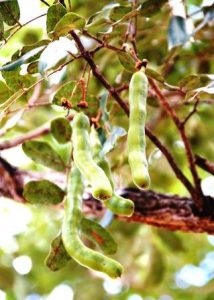
Swartzia madagascariensis, snake bean. Photo: Stephaan Dondeyne; Source: Flora of Zimbabwe
Walking through the Monotes glaber woodland we found Faurea speciosa in flower. Earlier we had seen the narrower leaves of F. saligna which no one appears to have succeeded growing from seed. Two Swartzia madagascariensis, both covered in long fat snake beans were admired as we reflected on their apparently poisonous properties.
We passed a Pittosporum viridiflorum, the botanical artist’s nightmare as one seldom finds a twiglet which lacks deformed leaves, and so with the great desire for perfection, most botanical artists ’recreate’ or apparently perfect reality that does not exist.
Having pottered around most of the morning, some of us caught upon some very rapid riverine botanizing, much of which consisted of open mouthed “My granny, what a big trunk you have got”. All the better for identification in fact. Albizia amara towered above us with leaves finely lacing the sky dome, while a riverine Rhus lancea bridged the stream. The banks were lined with Bequertiodendron magalismontanum as well as small Myrica serrata. Two exciting finds were Teclia rogersii and Chionanthus battiscombei. Teclia is a trifoliate shrub with a slightly winged petiole and numerous gland dots which are easily visible when held up to the light. This feature immediately characterizes this plant as a member of the citrus family, RUTACEAE. Chionanthus is the new name for the ironwood, Lonicera which we last saw on Wedza Mountain. The dark green leathery leaf has acarodomatia which are the little pockets in the axils of the leaf veins. This long name is simplified when one realizes that mites are classified as Acarina and – domatia refers to domain or house; under the microscope one does in fact find tiny plant mites within these pockets.
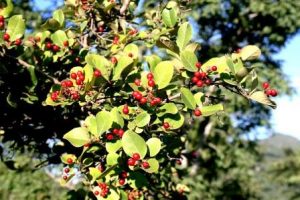
Christmas berry Psorospermum febrifugum. Photo: Mark Hyde. Source: Flora of Zimbabwe
There is only one tree in the holly family, the AQUIFOLIACEAE, south of the Zambezi. Ilex mitis, the African holly, has variable leaves, but a few holly like serrations were found on these riverine specimens. The leaf often has a mottled appearance and a channeled midvein. The sexes are on separate trees in the AQUIFOLIACEAE, which explains why so many horticultural immigrants never find fruit on the carefully nurtured imported holly, but for these hopefuls we had seen a lot of Christmas berry Psorospermum febrifugum. We were also impressed by small trees of Acokanthera oppositifolia, Euclea zeyheri as well as large Combretum erythrophyllum and Celtis africana.
On the return trip we found an exciting termitarium with Boscia salicifolia, Pappea capensis, Securinega virosa and, nearby, a young Kirkia acumiata, Steganotaenia araliacea and Catunaregam spinosa.
The afternoon’s walk up the kopje not only gave a superb view of the valley but we were also able to feel and rub the smooth trunks of two Commiphora species. C. africana has a grey bark and was practically leafless. The green paper bark C. marlothii provided excellent leverage to scramble up the rocks to do some ‘long distance botanizing’. Using binoculars someone identified both local species of Pavetta as well as find some Aloe excela.
We found a lot more, but I am sure there will be more time and space to discuss those species when next we see them. All in all a rewarding outing for which we would particularly like to thank Bob for helping with the identification.
-Kim St.J.Damstra
MATABELELAND NOTES
Sunday June 5th : To the Kalahari sand area on the northern boundary of Good Hope farm at Aisleby. Meet at Nell Baxendale’s flat, Eastlea, in Borrow Street, at 0830 at the Falls Road Garage at 0845 hours.
Sunday July 3rd : To the Matopos, but not very far in. A few yards along the Fort Usher road is a very interesting wooded kopje which would be worth investigating. Meet at Dora Webb’s house, 6 Caithness Road, Hillside, where you can fill up some cars and leave others in safety. 0830 hours.
Regrettably, the writer of these notes was away for the May outing, regrettably, because Meg and Paul Coates Palgrave were there so it was a rather special occasion. Now that we are leaderless we are very dependent on visits from ‘fundis’ and greatly appreciate their knowledge and guidance. The outing was to the Circular Drive area which, tree wise, is inexhaustible. It’s a granite area so the vegetation is Matopo like, but on the east it borders Acacia woodland. An analysis of the soils may prove interesting. Meg and Paul appear to have enjoyed the outing and were able to correct some of our erroneous identifications.
Meanwhile, the writer was reveling in the wonders of the Okavango. She was impressed by the enormous size of the trees, especially those along the waterways and by their prolific fruiting. Diospyros mespiliformis and Garcinia livingstonei were laden, not yet quite ripe but already attracting large numbers of birds, baboons and vervets. The fruits of both were sampled and were found to be quite palatable. Kigelia africana were heavy with their outsize ‘sausages’ and there was much evidence of these having been eaten by elephant and baboon. The enormous Sclerocarya birrea, Caffra, must have produced a big crop, but these had been almost totally consumed as there was very little evidence on the ground beneath. The waterways were lined with Ficus verruculosa, also laden with their red fruit and the number of winged seeds on Combretum hereroensis was unbelievable. It was difficult to find a pod from Acacia erioloba which had not been sampled by someone, and the vertical pods of Acacia hebeclada were intriguing. This Acacia has a shrubby, bushy growth under which lion like to lie up during the heat of the day. There were very many squirrels among the Colophospermum mopane, obviously feeding off the seeds and finding shelter in the numerous holes. The extent to which elephant have destroyed the trees, by ring-barking and up-rooting, was distressing to see, but quite a number, which had retained a precarious hold, were sprouting with new life. It would be interesting to return one day to check up on these.
-Dora Webb
Fortunately, although Dora Webb could not make it to the Circular Drive outing, Meg and Paul Coates Palgrave have supplied the following write up on it.
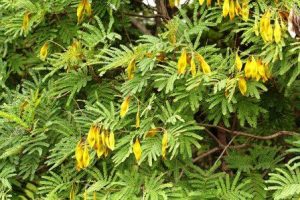
Peltophorum africanum. Photo: Mark Hyde. Source: Flora of Zimbabwe
Paul and I had the pleasure of joining the Matabeleland Branch on their May walk at Circular Drive. We saw a total of 68 species in the space of two hours in the very small area we covered. In January last year we had visited the same area and had had a long discussion about a specimen that could have been a Burkea africana without a velvet tip or an Albizia antunesiana with a purple tinge. In the end we were convinced by Geoff Archer that it was Burkea. On this occasion, remembering our tour of the Albizias in the Botanic Gardens, we were able to show our hosts the tell tale gland on the petiole of the Albizia immediately preventing confusion. We also looked at the gland on Albizia amara and compared its leaves with those of Peltophorum africanum with no gland and, it being the end of the season, we had to search before finding its fern like stipules. The books often say “stipules present; fall early”.
To Paul and I perhaps the highlight was finding Schrebera alata, a big tree in a sheltered position so that the wind blown seeds were either still in their wooden pear like pods or had dropped to the ground. Progress was halted for a while while everyone collected them for me.
The reason for this walk was the problem on the Terminalias. Many of them were characteristic Silver Terminalias, Terminalia sericea, but there were many others that were marked different with much darker leaves that had previously been believed to be Terminalia stenostachya until my write-up of the Terminalia Botanic Garden walk where I really put the cat among the pigeons or the trees among the Terminalias or vice versa, when I said “T. trichopoda occurs around Bulawayo and T. stenostachya does not”. So everyone was very keen to find out what these were. Certainly none of the trees had leaves in rosettes with pink petioles, the pointers one associates with T. stenostachya and all had the characteristic peeling twigs of T. sericea. So that is what we believe the answer to be in spite of the dark leaves.
There was one Terminalia we found, however, which was quite different. Its twigs were peeling only very slightly and there were indistinct leaf scars. T. trichopoda does not have conspicuous leaf scars like T. stenostachya and does have peeling branchlets. So there is little doubt about the identity of that one.
A point to look for in the future to verify our identification is the size of the fruits; those of T. sericea are at maximum 3.5 by 2.5 cm while those of T. trichopoda are much larger, being up to 7.5 x 4.2 cm. The leaves, too, might help; those of T. sericea are 5.5 to 12 by 1.5 to 4.5 cm while those of T. trichopoda are also bigger, being usually 13 to 15 by 4 to 6 cm. The petioles follow the same patterns; those of T. sericea are up to 1 cm long and those of T. trichopoda are up to 2 cm long.
And there are the in-betweens; also called the hybrids. To quote from Common Trees of the Central Watershed Woodlands of Zimbabwe “T. sericea is closely related to T. trichopoda with which it freely hybridizes.”
One of these days when I have sorted out the true species, I shall be able to turn my attention to the hybrids. In the meantime, having met the members of the Matabeleland Branch and having seen their interest, tenacity and enthusiasm, I believe that the next time we have the pleasure of joining them on an outing they will have all the answers and we will be told which species is which and which are hybrids.
-Meg Coates Palgrave
ROOT NOTES Although not in response to my appeal last month for literary contributions, I was fortunate to get Meg’s write up on the Bulawayo outing and Dora Webb’s Okavango write-up. In addition I have a couple of “advertisement” inclusions.
HWANGE BUSA CAMP AT DETE VLEI under management of Wankie Safari Lodge. We have seen a rather attractive offer as a “Special Interest” group to fly to Hwange to stay at Dete Vlei Bush Camp, sleeping in tree houses etc. Garth Thompson the Safari Lodge ranger who would be our host has supplied us with a suggested three-day itinerary describing exciting jaunts to various pans, woodlands, waterholes, riverine, Kalahari sand-dunes etc. where a fascinating variety of trees would be seen, along with shrubs, grasses and of course the game herds and tremendous numbers of birds. The tree list is, honestly, tantalizing, and the whole idea sounds fabulous. There is no security problem.
The trip envisaged is based on a two night “Great Escape” trip from Harare which includes return air fare and bed and breakfast at Lodge rates. This basic cost at current rates would be $151 per person which because of the special deal compares with c. $183 you would pay for air flights alone. However, for our Special Interest trip, with all the jaunts, other meals, beverages etc. another $60 would be charged over that giving a total of $211 at current rates.
To make this work we would want, ideally, 16 people, but as little as 6 would still make it viable. Virtually any time will do, and I was assured that this would also apply to holiday periods such as Heroes Days.
Obviously, such a trip would not be an “outing” as such and would only appeal to a certain sector of our membership, but I feel it is still worth sounding out interest. Anyone interested, then please let me know by phone, letter or personally. A coordinator would probably be useful.
I hasten to add that although this trip is aimed at Hararians who would fly in, an equally attractive and probably cheaper trip could be arranged from Bulawayo, possibly using a coach.
MUKUVISI WOODLAND ASSOCIATION have appealed for volunteers to assist at Cake Sales to be run on a monthly basis, and at projected Tombola and Casino functions. They also appeal for Jumble. All this is part of the effort to raise funds to help meet day to day running expenses, and to try to improve the immediately surrounds of the car park. Anyone keen to help please phone the Secretary at 50322
-Phil Haxen Telephone : Home 8871413 Business 703353


